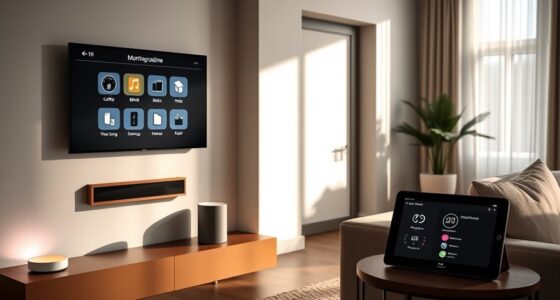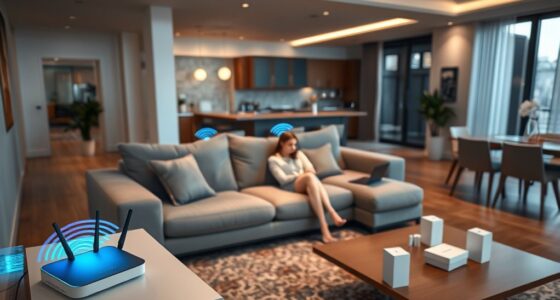Choosing between smart switches and smart bulbs depends on your needs. If you want centralized control and a clean, integrated look, smart switches are a great choice—they work with multiple fixtures and control everything from one place. For quick upgrades and individual customization, smart bulbs are easy to install and offer features like color-changing and dimming. Want to discover which option fits your lifestyle best? Keep exploring to find out more.
Key Takeaways
- Smart switches control multiple fixtures and integrate seamlessly with existing wiring, ideal for centralized lighting management.
- Smart bulbs are easy to install, offer customizable colors, and are perfect for quick upgrades without rewiring.
- Smart switches require electrical installation but provide more comprehensive control and a cleaner look.
- Smart bulbs operate independently, are suitable for renters, and support features like dimming and color-changing effects.
- Choose smart switches for extensive, integrated control; pick smart bulbs for flexibility and simple setup.

When it comes to upgrading your home lighting, choosing between smart switches and smart bulbs can seem intimidating. Both options offer modern convenience, but understanding their differences helps you make the best choice for your needs. One key factor to contemplate is wireless compatibility. Smart switches typically connect directly to your home’s Wi-Fi or Zigbee/Z-Wave networks, allowing you to control your lights through apps or voice commands without needing to replace existing bulbs. In contrast, smart bulbs are standalone devices that screw into your standard sockets, often requiring their own Wi-Fi or Bluetooth connection. This means smart switches integrate seamlessly with your existing fixtures and can control multiple bulbs at once, providing a more centralized control system.
Energy savings is another major aspect to evaluate. Smart switches allow you to turn off lights completely when not in use, preventing unnecessary energy consumption across multiple bulbs or fixtures. They also let you set schedules or timers, ensuring lights aren’t left on longer than needed, which can considerably cut down your electricity bills. Smart bulbs, on the other hand, often come with energy-efficient LED technology built-in, and some models allow dimming capabilities that help reduce power consumption. However, because smart bulbs are individual units, replacing them with more energy-efficient models might be more costly over time than installing a smart switch that controls multiple fixtures at once.
The installation process is another factor to keep in mind. Smart switches generally require replacing your existing wall switch, which might involve some electrical work if you’re not comfortable with wiring. They’re ideal for controlling multiple bulbs or fixtures in a room, especially if you want a cleaner look without visible bulbs. Smart bulbs, meanwhile, are easy to install—just screw them into your existing sockets—making them perfect for renters or those who want a quick upgrade without rewiring. Additionally, the high contrast ratio of certain projectors can greatly improve viewing in various lighting conditions, which is an important aspect of home cinema setup.
Control options also differ. Smart switches typically work with voice assistants like Alexa, Google Assistant, or Siri, allowing you to turn lights on or off with simple commands. They might also support advanced features like scene setting or remote control through apps. Smart bulbs often come with their own apps, offering color-changing options and dimming features that can personalize your ambiance.
Ultimately, your choice depends on your home’s setup and your priorities. If you want a sleek, integrated system that controls many fixtures with minimal fuss, smart switches are a strong choice. If you prefer flexibility, colorful lighting, or quick upgrades, then smart bulbs might be better suited. Both options enhance convenience and energy efficiency, but understanding their differences helps you select the right solution for your home.
Frequently Asked Questions
Can Smart Switches Control Non-Smart Bulbs?
Yes, smart switches can control non-smart bulbs if you use smart switches with wireless control capabilities. These switches act as a relay, turning your existing bulbs on or off via your smartphone or voice commands, provided they’re compatible with your voice assistant. However, keep in mind that smart switches generally don’t allow dimming unless specified. Check voice compatibility to guarantee smooth control, making your setup more integrated and user-friendly.
Are Smart Bulbs Compatible With All Dimmer Switches?
When considering dimmer switches, you wonder if smart bulbs are compatible with all of them. Dimming compatibility varies among smart bulbs, so you need to check the manufacturer’s specifications to guarantee they work with your specific dimmer switch. Some smart bulbs are designed for dimming, but not all, so verifying bulb compatibility helps you avoid flickering or functionality issues. Always confirm the compatibility before installation for peak performance.
Do Smart Switches Require Neutral Wiring?
Did you know over 60% of homes lack neutral wiring? Smart switches often do require neutral wiring for power, which impacts installation complexity. If your home doesn’t have neutral wires, wireless compatibility might be limited, and installing a smart switch could be more challenging. You’ll want to check your wiring before purchasing, as this influences whether you can easily upgrade your switches or need alternative solutions.
Can Smart Bulbs Be Used Outdoors Safely?
Yes, you can use smart bulbs outdoors safely if they’re designed for outdoor durability and weather resistance. Look for bulbs specifically labeled for outdoor use, as they can withstand rain, snow, and temperature changes. Make sure to install them in weatherproof fixtures to protect against moisture. This guarantees your smart bulbs operate reliably and last longer, giving you convenient control over your outdoor lighting in all weather conditions.
Which Option Offers Better Energy Savings Long-Term?
When considering energy savings long-term, you might notice that smart switches often offer more control over ambient lighting, allowing you to dim or turn off lights efficiently, reducing waste. They work seamlessly with voice control, making adjustments quick and effortless. While smart bulbs can be energy-efficient, smart switches tend to save more overall, especially when managing multiple bulbs, because they cut power entirely when lights are off, ensuring better long-term savings for your home.
Conclusion
Ultimately, choosing between smart switches and smart bulbs depends on your control needs. A switch offers broader control, fitting seamlessly into your existing setup, while a bulb provides flexibility and color options. Think of the switch as the backbone of your lighting system—powerful and reliable—whereas the bulb adds personality and ambiance. Both have their strengths; your decision hinges on whether you prioritize extensive control or customizable lighting experiences.









